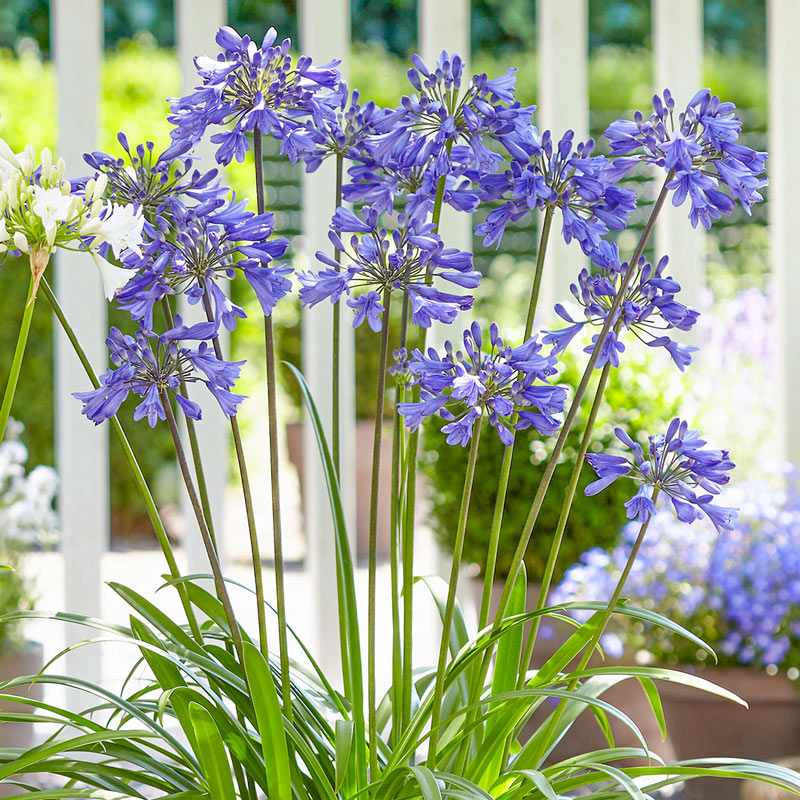Agapanthus Friend Plant Kingdoms: Perfect Pairings for Your Yard
Agapanthus Friend Plant Kingdoms: Perfect Pairings for Your Yard
Blog Article
Unleashing the Secret to Successful Agapanthus Cultivation: Advice for a Flourishing Yard
In the realm of gardening, growing agapanthus effectively requires a strategic approach that incorporates different facets of plant treatment. By recognizing the subtleties of agapanthus cultivation, one can create a setting where these plants prosper and flower abundantly.
Growing Agapanthus: Best Practices
When planting Agapanthus, proper dirt preparation is crucial for making certain effective development and advancement of these attractive blossoms. Agapanthus, generally referred to as Lily of the Nile or African lily, flourishes in well-draining dirt with a slightly acidic to neutral pH degree - Agapanthus. Prior to planting, it is crucial to change heavy clay soils with natural matter such as garden compost or peat moss to improve drainage and provide important nutrients for the plants
To plant Agapanthus, pick an area that gets full sunlight to partial shade, as this will advertise healthy and balanced growth and bountiful flowering. Dig a hole two times the diameter of the plant's root sphere and position the Agapanthus at the same deepness it was formerly expanding. Carefully backfill the hole with dirt, pushing down strongly to remove any kind of air pockets around the origins.
Water the recently grown Agapanthus extensively and remain to maintain the dirt evenly moist, specifically throughout the plant's active expanding period. Agapanthus. Applying a well balanced fertilizer once a month can additionally sustain the plant's development and blooming. By following these best practices for planting Agapanthus, you can develop a sensational display of these exciting blossoms in your garden
Perfect Dirt Issues for Agapanthus
For optimum development and blooming success of Agapanthus plants, ensuring the soil problems are ideal is crucial. Agapanthus prospers in well-draining dirt with a somewhat acidic to neutral pH level varying from 6.0 to 7.0. This sort of soil permits adequate water drain, stopping waterlogging which can result in root rot. To enhance soil drain, consider adding natural issue such as compost or peat moss when preparing the planting site. Furthermore, Agapanthus chooses soil that is rich in nutrients, so incorporating a balanced fertilizer during the growing period can advertise healthy growth and vivid flowers.

Watering and Fertilizing Tips
To make certain healthy growth and lively blossoms, proper watering and fertilizing techniques are essential for successful Agapanthus cultivation. Agapanthus plants profit from routine watering, especially throughout the expanding period.
When it concerns feeding Agapanthus, a balanced fertilizer with equivalent parts nitrogen, phosphorus, and potassium can be applied in the springtime to advertise healthy development and blooming. Slow-release plant foods are perfect for providing nutrients slowly over a prolonged period. Avoid over-fertilizing, as this can lead to excessive vegetation growth at the expense of blossoms.
In addition, integrating raw material like compost into the dirt can enhance nutrient visit here levels and boost dirt framework, aiding in the overall health of the Agapanthus plants. By adhering to these watering and fertilizing tips, gardeners can ensure their Agapanthus plants prosper and produce sensational display screens of blossoms.
Pruning and Deadheading Techniques
Proper trimming and deadheading techniques play a vital duty in keeping the health and wellness and aesthetic appeals of Agapanthus plants, matching the important techniques of watering and feeding for successful farming. Pruning Agapanthus involves getting rid of spent flower heads, yellowing or dead fallen leaves, and total shaping of the plant to advertise better development. Deadheading, the process of removing discolored blossoms, not only enhances the plant's look however additionally encourages more flowering.
When deadheading Agapanthus, it is advisable to trim off the blossom stem at the base making use of sharp, clean shears. This procedure reroutes the plant's energy from seed production back into origin and foliage growth, advertising a healthier and a lot more durable plant. Regular deadheading can expand the growing period of Agapanthus and prevent self-seeding, which can result in congestion.
In regards to pruning, Agapanthus normally benefits from a light trim after blooming to clean up the plant and urge fresh growth. Reducing the invested blossom stems and removing any dead or damaged vegetation helps keep the plant's vigor and general look. Nevertheless, it is necessary to prevent cutting into the crown of the plant, as this can compromise its wellness.

Protecting Agapanthus From Vermins and Diseases
Executing effective insect and disease monitoring strategies is essential to protecting the wellness and vitality of Agapanthus plants in cultivation. One usual parasite that impacts Agapanthus hop over to these guys is the Agapanthus borer, a caterpillar that tunnels into the plant, causing damages to the leaves and blossoms.
In enhancement to pests, Agapanthus are vulnerable to diseases such as origin rot and fungal leaf areas. By remaining vigilant and addressing bug and illness problems promptly, gardeners can help their Agapanthus grow and prosper.

Verdict
To conclude, effective growing of agapanthus requires proper growing techniques, optimal soil conditions, sufficient watering and fertilizing, normal pruning and deadheading, and security from insects and diseases. By following these methods and pointers, garden enthusiasts can make certain a growing yard loaded with beautiful agapanthus blossoms. Agapanthus. Remember to preserve regular care and interest to detail to promote the health and wellness and longevity of these stunning plants
When growing Agapanthus, correct soil prep work is necessary for making certain successful development and growth of these gorgeous flowers.Water the freshly grown Agapanthus thoroughly and proceed to maintain the dirt evenly moist, particularly throughout the plant's energetic expanding season.For ideal development and growing success of Agapanthus plants, ensuring the dirt problems are ideal is essential. When growing or transplanting Agapanthus, ensure the dirt is well-prepared to give the required foundation for the plants to develop themselves successfully. Get More Info One typical bug that impacts Agapanthus is the Agapanthus borer, a caterpillar that passages into the plant, causing damage to the flowers and leaves.
Report this page